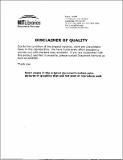| dc.contributor.advisor | Leonard Guarente. | en_US |
| dc.contributor.author | Armstrong, Christopher Mark, 1972- | en_US |
| dc.contributor.other | Massachusetts Institute of Technology. Dept. of Biology. | en_US |
| dc.date.accessioned | 2005-08-23T18:19:37Z | |
| dc.date.available | 2005-08-23T18:19:37Z | |
| dc.date.copyright | 2001 | en_US |
| dc.date.issued | 2001 | en_US |
| dc.identifier.uri | http://hdl.handle.net/1721.1/8210 | |
| dc.description | Thesis (Ph. D.)--Massachusetts Institute of Technology, Dept. of Biology, 2001. | en_US |
| dc.description | Includes bibliographical references. | en_US |
| dc.description.abstract | A gene's location in the genome can have profound effects on its ekpression. In Saccharomyces cerevisiae, the gene SIR2 is crucial for silencing at the HM mating type loci, the telomeres, and the rDNA array. It is also necessary for maintaining a hypoacetylated state of the histones at these locations. To silence genes, the Sir2 protein can deacetylate histones in the presence of NAD+. This is shown by the ability of Sir2p to remove the acetyl groups from peptides corresponding to the amino-terminal tail of histone H3 or histone H4. It selectively removes the acetyl group from lysine 16 on histone H4. This lysine plays a particularly crucial role in SIR2 dependent silencing. Sir2p can also ADP-ribosylate histones, but this activity is significantly weaker than its histone deacetylase activity. Mutations in Sir2p that affect its ability to deacetylate histones can affect SIR2 function in vivo. Mutations that completely destroy the ability of Sir2p to deacetylate histones also render SIR2 unable to silence. Two mutations, however, do not show a direct correlation between in vitro and in vivo activity. One mutant has nearly full levels of activity in vitro, but is unable to silence in vivo while the other has severely compromised in vitro activity, but show no sign of defect in vivo. Localization studies of the mutants suggest that the enzymatic activity of Sir2p is necessary for the SIR complex to localize to the telomeres although it is not necessary for Sir2p to localize to the rDNA. The results suggest that while the function of SIR2 appears to be to deacetylate histones at silent loci, that we do not yet fully understand how SIR2 does this. | en_US |
| dc.description.statementofresponsibility | by Christopher Mark Armstrong. | en_US |
| dc.format.extent | 129 p. | en_US |
| dc.format.extent | 9914878 bytes | |
| dc.format.extent | 9914633 bytes | |
| dc.format.mimetype | application/pdf | |
| dc.format.mimetype | application/pdf | |
| dc.language.iso | eng | en_US |
| dc.publisher | Massachusetts Institute of Technology | en_US |
| dc.rights | M.I.T. theses are protected by copyright. They may be viewed from this source for any purpose, but reproduction or distribution in any format is prohibited without written permission. See provided URL for inquiries about permission. | en_US |
| dc.rights.uri | http://dspace.mit.edu/handle/1721.1/7582 | |
| dc.subject | Biology. | en_US |
| dc.title | Characterization of the histone deacetylation activity of the yeast silencing gene SIR2 | en_US |
| dc.type | Thesis | en_US |
| dc.description.degree | Ph.D. | en_US |
| dc.contributor.department | Massachusetts Institute of Technology. Department of Biology | |
| dc.identifier.oclc | 50120377 | en_US |
